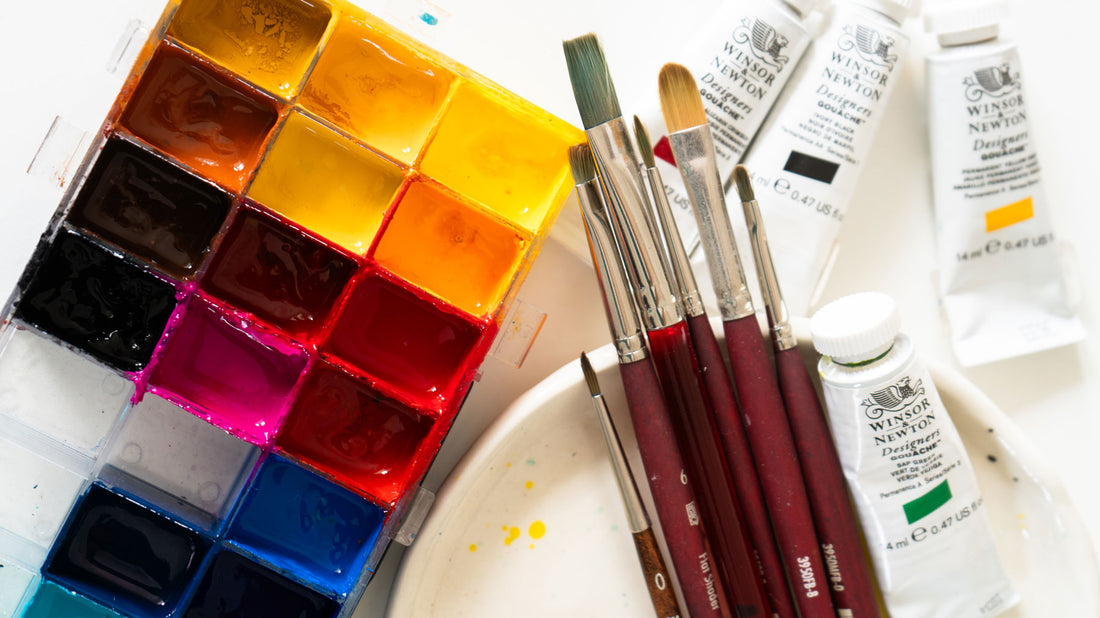Gouache vs Watercolor vs Acrylic Paint: The Ultimate Comparison

Share
I primarily paint with Gouache and watercolours but I recently tried painting with Acrylic and even finished painting a piece with it. I wanted to share my experience with these 3 mediums and how they differ from each other in terms of their properties, how they behave and their uses. Check out the video to see Swatches and watch me work with the three mediums!
Form
Watercolours come in tubes or pans (in cakes). I usually get watercolour tubes and then lay them out in pans because I find it easier to work with them that way. You also get liquid watercolours that come in bottles with droppers.
Gouache typically comes in tubes, but you can also find jelly gouaches that come in tubs. I get gouache paint tubes and store them in an airtight palette. This helps protect my paint and helps me see, pick, and work with them more easily.
Acrylic paints primarily come in tubes that you can squeeze out of but only as and when needed, and I’ll get into the why of it in a moment.
Texture and opacity
With watercolours, as the name suggests, a lot of water is used to work with it. It’s a transparent medium that gives beautiful and textural washes of colour. To lighten the colour or decrease the opacity, all you have to do is add more water.
Gouache, otherwise known as opaque watercolour, is highly pigmented, opaque, thicker and creamier in texture. However, you can add water to lighten it or make it more transparent. Of course, gouache doesn’t work exactly the same as watercolour when you water it down but it does work well for uses like background washes.
Acrylic is also an opaque medium like gouache but that’s where the similarities end. It doesn’t move as easily and has a more plasticky feel to it.
Lightening the paint
To lighten watercolours, you can just add water to it but to lighten gouache and acrylic paints, you have to use white.
Drying & Layering
Both watercolour and gouache dries flat and matte but with Acrylic, you can create a lot of texture thanks to its texture using tools like palette knives. You’ll also get a more glossy finish.
With watercolours, you can layer dark on light but it’s quite challenging to layer light on dark unless you are trying to create some effects or glaze.
With Gouache and Acrylic, you can layer either dark on light or light on dark however with Acrylic, you might have to use 2 or 3 coats to get a perfectly opaque layer. With Gouache, just one layer will still give you a very opaque layer.
Reactivating & blending
Both watercolour and gouache can be reactivated with water. However, here’s how they differ:
Watercolours tend to get soaked up by the paper and bind with it so it can’t be reactivated too much and even when you do, it might leave behind some harsh lines. One thing you can do with watercolours is use a wet brush to lift off paint from your artwork to create texture, gradient, or other effects.
Gouache on the other hand will reactivate very smoothly as gouache has the property to sit on top of the paper and not get as soaked up by the paper. Acrylic cannot be reactivated at all. If it dries, it’s set, whether it’s on paper or on your palette. This is why initially I had mentioned that with Acrylic, you take the amount of colour you want onto your palette and not more.
With Gouache on the other hand, you can reactivate the paints on your palette or on the paper, infinitely. When you are mixing paints on your palette, you can comfortably mix more than you need, and reactivate it for other projects in the future.
Acrylic + gouache??
Ok, before we go ahead and talk about the different uses of these mediums, here’s a new one that I think is quite cool: Acrylic Gouache. Acrylic Gouache brings together the best qualities of gouache and acrylic. It’s a medium that dries matte like gouache but works like acrylic, in the sense that it cannot be reactivated and therefore you can layer it without worrying about reactivating the base layer. You can also create a lot of dimension and texture with it.
Applications
All three mediums are very versatile and can be used for various subject matters and styles. Watercolour works well to create watercolour landscapes and its transparency allows you to bring in a lot of dimension and texture to your work.
Gouache works beautifully for flat illustrative styles but it also does well when you layer or blend colours together. It’s very versatile and if you’d like to learn more about gouache and how to paint with it, be sure to check out my online courses where you’ll learn from scratch about painting, painting with gouache and even painting a piece all by yourself by the end of it.
Acrylic is by far the best of the three mediums to work on Canvas. However, if you’d like a gouache-like finish on a canvas you can try using Acrylic Gouache.
